Diabetes Burden in Australia: National Strategy and Nursing Roles
VerifiedAdded on 2022/11/16
|14
|4083
|373
Report
AI Summary
This report provides a comprehensive overview of the diabetes burden in Australia, highlighting its prevalence, economic impact, and associated health complications. It discusses the Australian National Diabetes Strategy 2016-2020, outlining the government's initiatives to address the epidemic, including prevention, detection, and management strategies. The report analyzes the strategy's key components, such as collaboration, resource coordination, and the involvement of various stakeholders. Furthermore, it emphasizes the crucial role of registered nursing professionals in implementing the strategy, focusing on health education, promoting healthy lifestyles, and managing diabetes complications within communities. The report underscores the importance of cultural competency and individualized care, particularly for vulnerable populations such as indigenous communities, while also acknowledging the limitations of the strategy in this regard.
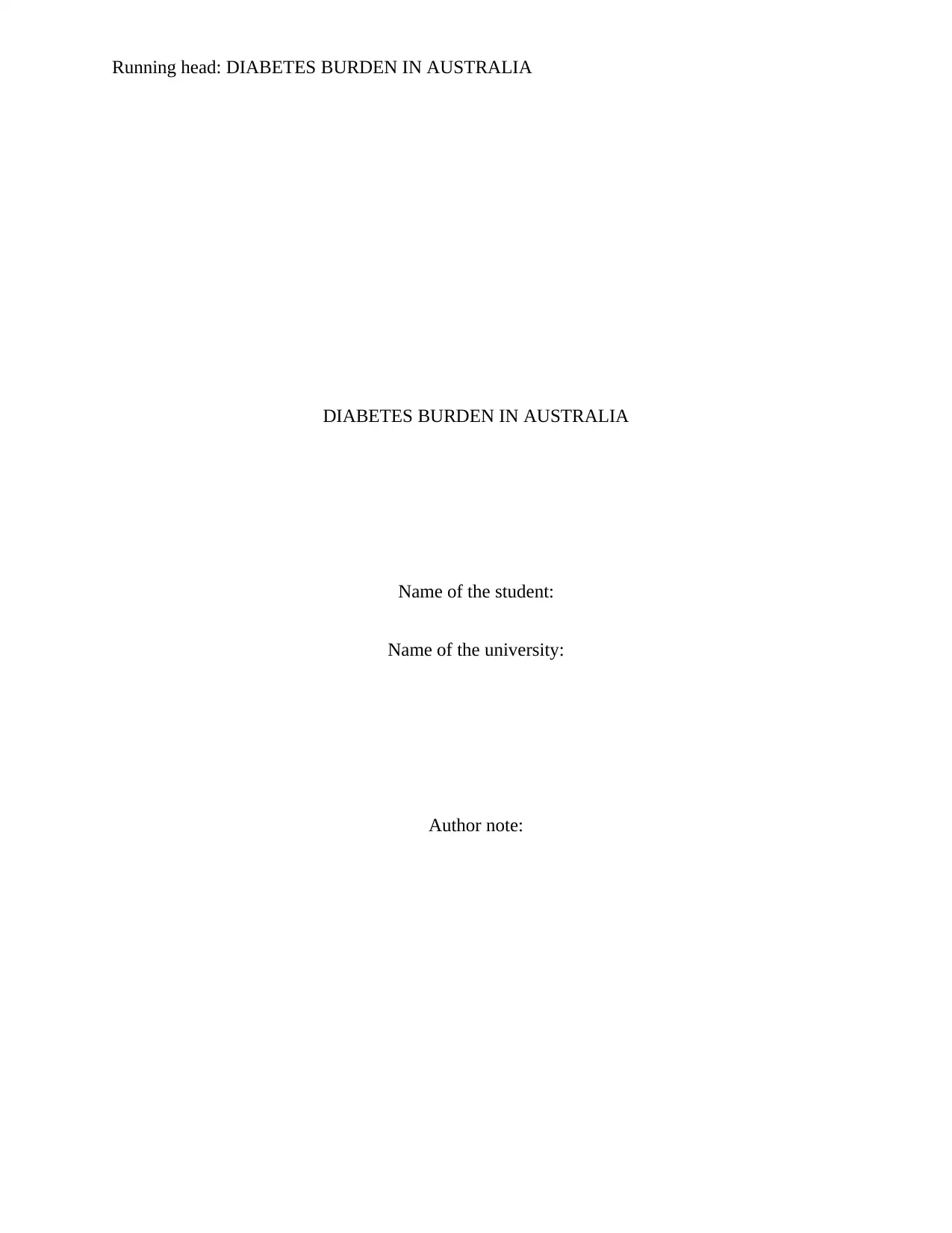
Running head: DIABETES BURDEN IN AUSTRALIA
DIABETES BURDEN IN AUSTRALIA
Name of the student:
Name of the university:
Author note:
DIABETES BURDEN IN AUSTRALIA
Name of the student:
Name of the university:
Author note:
Paraphrase This Document
Need a fresh take? Get an instant paraphrase of this document with our AI Paraphraser
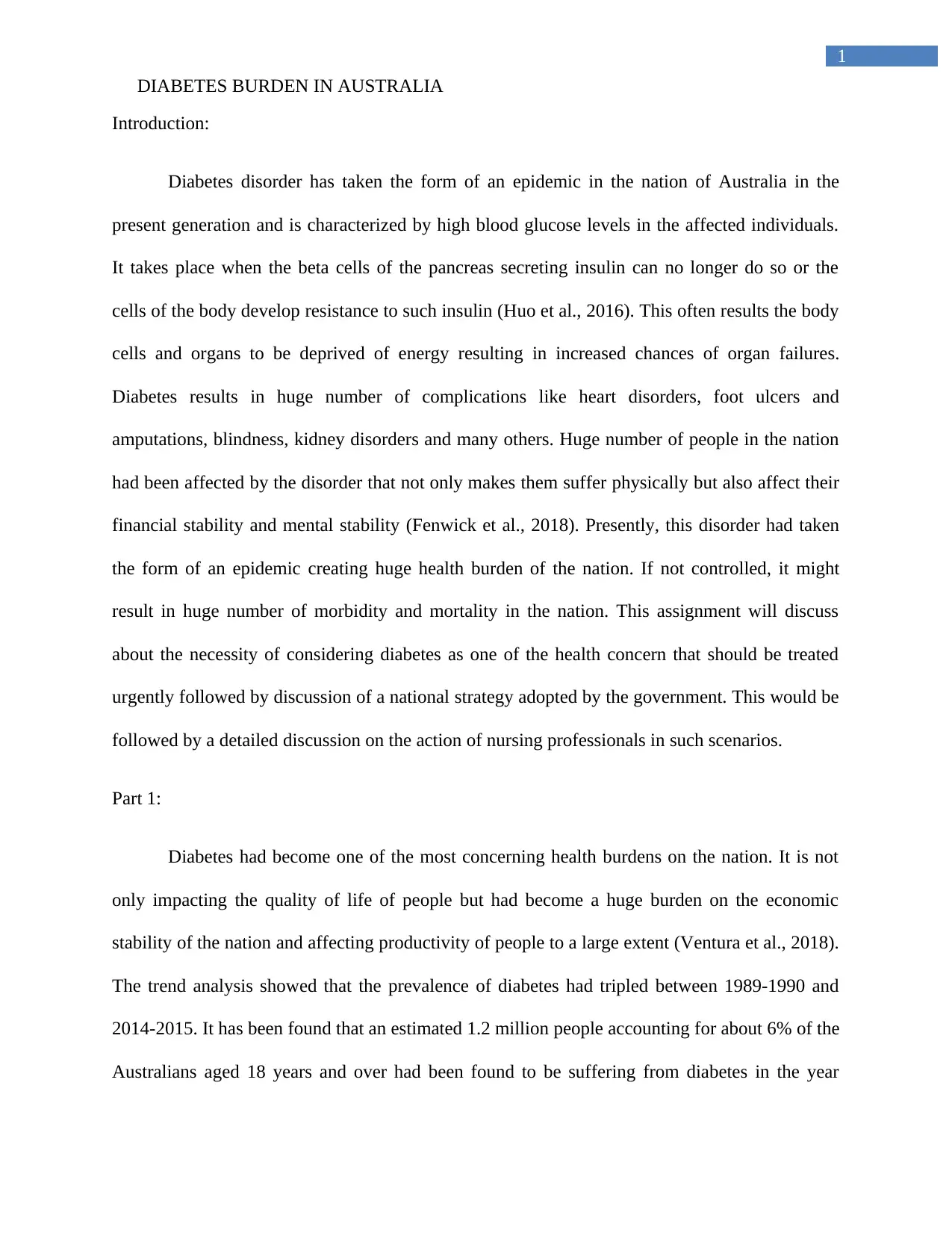
1
DIABETES BURDEN IN AUSTRALIA
Introduction:
Diabetes disorder has taken the form of an epidemic in the nation of Australia in the
present generation and is characterized by high blood glucose levels in the affected individuals.
It takes place when the beta cells of the pancreas secreting insulin can no longer do so or the
cells of the body develop resistance to such insulin (Huo et al., 2016). This often results the body
cells and organs to be deprived of energy resulting in increased chances of organ failures.
Diabetes results in huge number of complications like heart disorders, foot ulcers and
amputations, blindness, kidney disorders and many others. Huge number of people in the nation
had been affected by the disorder that not only makes them suffer physically but also affect their
financial stability and mental stability (Fenwick et al., 2018). Presently, this disorder had taken
the form of an epidemic creating huge health burden of the nation. If not controlled, it might
result in huge number of morbidity and mortality in the nation. This assignment will discuss
about the necessity of considering diabetes as one of the health concern that should be treated
urgently followed by discussion of a national strategy adopted by the government. This would be
followed by a detailed discussion on the action of nursing professionals in such scenarios.
Part 1:
Diabetes had become one of the most concerning health burdens on the nation. It is not
only impacting the quality of life of people but had become a huge burden on the economic
stability of the nation and affecting productivity of people to a large extent (Ventura et al., 2018).
The trend analysis showed that the prevalence of diabetes had tripled between 1989-1990 and
2014-2015. It has been found that an estimated 1.2 million people accounting for about 6% of the
Australians aged 18 years and over had been found to be suffering from diabetes in the year
DIABETES BURDEN IN AUSTRALIA
Introduction:
Diabetes disorder has taken the form of an epidemic in the nation of Australia in the
present generation and is characterized by high blood glucose levels in the affected individuals.
It takes place when the beta cells of the pancreas secreting insulin can no longer do so or the
cells of the body develop resistance to such insulin (Huo et al., 2016). This often results the body
cells and organs to be deprived of energy resulting in increased chances of organ failures.
Diabetes results in huge number of complications like heart disorders, foot ulcers and
amputations, blindness, kidney disorders and many others. Huge number of people in the nation
had been affected by the disorder that not only makes them suffer physically but also affect their
financial stability and mental stability (Fenwick et al., 2018). Presently, this disorder had taken
the form of an epidemic creating huge health burden of the nation. If not controlled, it might
result in huge number of morbidity and mortality in the nation. This assignment will discuss
about the necessity of considering diabetes as one of the health concern that should be treated
urgently followed by discussion of a national strategy adopted by the government. This would be
followed by a detailed discussion on the action of nursing professionals in such scenarios.
Part 1:
Diabetes had become one of the most concerning health burdens on the nation. It is not
only impacting the quality of life of people but had become a huge burden on the economic
stability of the nation and affecting productivity of people to a large extent (Ventura et al., 2018).
The trend analysis showed that the prevalence of diabetes had tripled between 1989-1990 and
2014-2015. It has been found that an estimated 1.2 million people accounting for about 6% of the
Australians aged 18 years and over had been found to be suffering from diabetes in the year
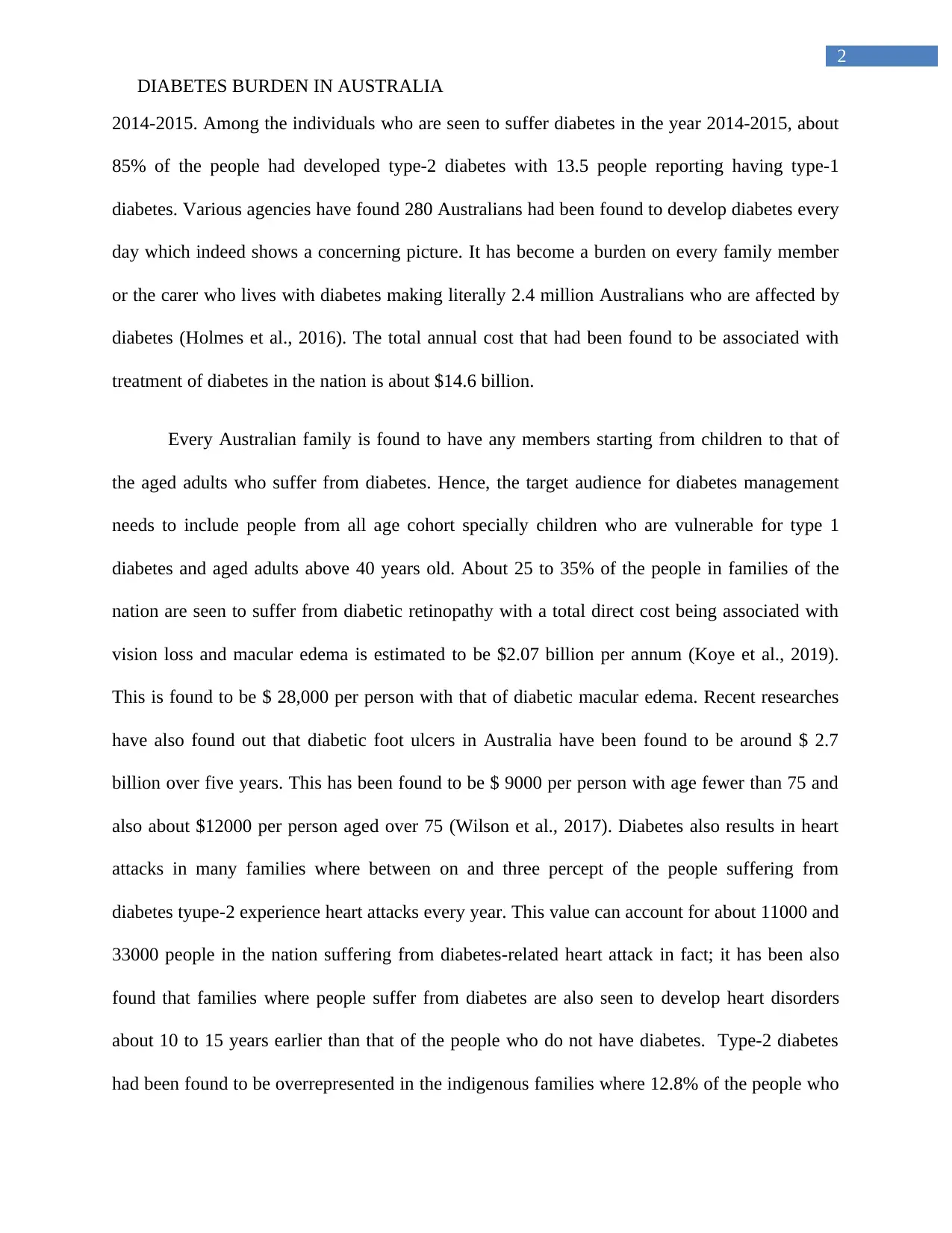
2
DIABETES BURDEN IN AUSTRALIA
2014-2015. Among the individuals who are seen to suffer diabetes in the year 2014-2015, about
85% of the people had developed type-2 diabetes with 13.5 people reporting having type-1
diabetes. Various agencies have found 280 Australians had been found to develop diabetes every
day which indeed shows a concerning picture. It has become a burden on every family member
or the carer who lives with diabetes making literally 2.4 million Australians who are affected by
diabetes (Holmes et al., 2016). The total annual cost that had been found to be associated with
treatment of diabetes in the nation is about $14.6 billion.
Every Australian family is found to have any members starting from children to that of
the aged adults who suffer from diabetes. Hence, the target audience for diabetes management
needs to include people from all age cohort specially children who are vulnerable for type 1
diabetes and aged adults above 40 years old. About 25 to 35% of the people in families of the
nation are seen to suffer from diabetic retinopathy with a total direct cost being associated with
vision loss and macular edema is estimated to be $2.07 billion per annum (Koye et al., 2019).
This is found to be $ 28,000 per person with that of diabetic macular edema. Recent researches
have also found out that diabetic foot ulcers in Australia have been found to be around $ 2.7
billion over five years. This has been found to be $ 9000 per person with age fewer than 75 and
also about $12000 per person aged over 75 (Wilson et al., 2017). Diabetes also results in heart
attacks in many families where between on and three percept of the people suffering from
diabetes tyupe-2 experience heart attacks every year. This value can account for about 11000 and
33000 people in the nation suffering from diabetes-related heart attack in fact; it has been also
found that families where people suffer from diabetes are also seen to develop heart disorders
about 10 to 15 years earlier than that of the people who do not have diabetes. Type-2 diabetes
had been found to be overrepresented in the indigenous families where 12.8% of the people who
DIABETES BURDEN IN AUSTRALIA
2014-2015. Among the individuals who are seen to suffer diabetes in the year 2014-2015, about
85% of the people had developed type-2 diabetes with 13.5 people reporting having type-1
diabetes. Various agencies have found 280 Australians had been found to develop diabetes every
day which indeed shows a concerning picture. It has become a burden on every family member
or the carer who lives with diabetes making literally 2.4 million Australians who are affected by
diabetes (Holmes et al., 2016). The total annual cost that had been found to be associated with
treatment of diabetes in the nation is about $14.6 billion.
Every Australian family is found to have any members starting from children to that of
the aged adults who suffer from diabetes. Hence, the target audience for diabetes management
needs to include people from all age cohort specially children who are vulnerable for type 1
diabetes and aged adults above 40 years old. About 25 to 35% of the people in families of the
nation are seen to suffer from diabetic retinopathy with a total direct cost being associated with
vision loss and macular edema is estimated to be $2.07 billion per annum (Koye et al., 2019).
This is found to be $ 28,000 per person with that of diabetic macular edema. Recent researches
have also found out that diabetic foot ulcers in Australia have been found to be around $ 2.7
billion over five years. This has been found to be $ 9000 per person with age fewer than 75 and
also about $12000 per person aged over 75 (Wilson et al., 2017). Diabetes also results in heart
attacks in many families where between on and three percept of the people suffering from
diabetes tyupe-2 experience heart attacks every year. This value can account for about 11000 and
33000 people in the nation suffering from diabetes-related heart attack in fact; it has been also
found that families where people suffer from diabetes are also seen to develop heart disorders
about 10 to 15 years earlier than that of the people who do not have diabetes. Type-2 diabetes
had been found to be overrepresented in the indigenous families where 12.8% of the people who
⊘ This is a preview!⊘
Do you want full access?
Subscribe today to unlock all pages.

Trusted by 1+ million students worldwide
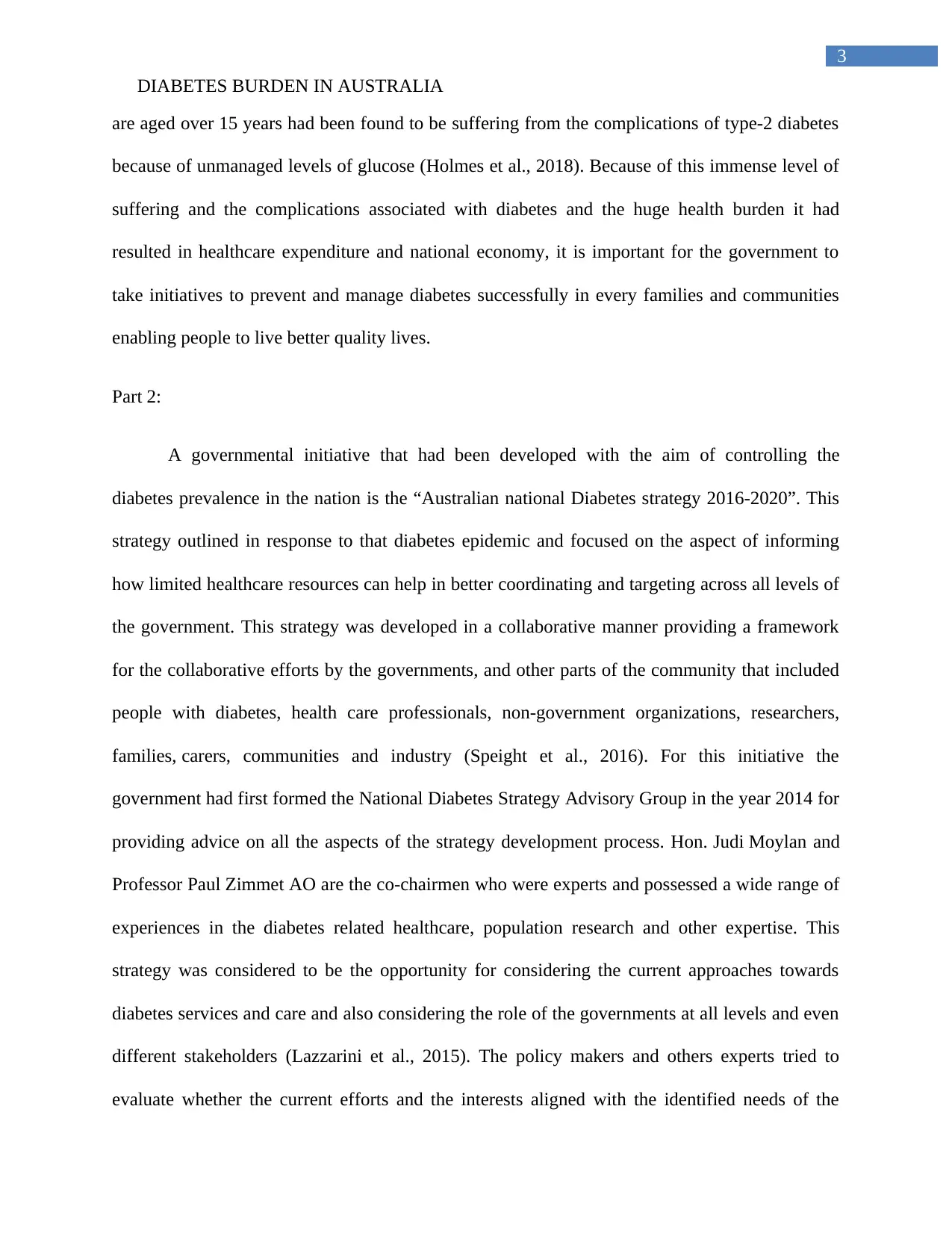
3
DIABETES BURDEN IN AUSTRALIA
are aged over 15 years had been found to be suffering from the complications of type-2 diabetes
because of unmanaged levels of glucose (Holmes et al., 2018). Because of this immense level of
suffering and the complications associated with diabetes and the huge health burden it had
resulted in healthcare expenditure and national economy, it is important for the government to
take initiatives to prevent and manage diabetes successfully in every families and communities
enabling people to live better quality lives.
Part 2:
A governmental initiative that had been developed with the aim of controlling the
diabetes prevalence in the nation is the “Australian national Diabetes strategy 2016-2020”. This
strategy outlined in response to that diabetes epidemic and focused on the aspect of informing
how limited healthcare resources can help in better coordinating and targeting across all levels of
the government. This strategy was developed in a collaborative manner providing a framework
for the collaborative efforts by the governments, and other parts of the community that included
people with diabetes, health care professionals, non-government organizations, researchers,
families, carers, communities and industry (Speight et al., 2016). For this initiative the
government had first formed the National Diabetes Strategy Advisory Group in the year 2014 for
providing advice on all the aspects of the strategy development process. Hon. Judi Moylan and
Professor Paul Zimmet AO are the co-chairmen who were experts and possessed a wide range of
experiences in the diabetes related healthcare, population research and other expertise. This
strategy was considered to be the opportunity for considering the current approaches towards
diabetes services and care and also considering the role of the governments at all levels and even
different stakeholders (Lazzarini et al., 2015). The policy makers and others experts tried to
evaluate whether the current efforts and the interests aligned with the identified needs of the
DIABETES BURDEN IN AUSTRALIA
are aged over 15 years had been found to be suffering from the complications of type-2 diabetes
because of unmanaged levels of glucose (Holmes et al., 2018). Because of this immense level of
suffering and the complications associated with diabetes and the huge health burden it had
resulted in healthcare expenditure and national economy, it is important for the government to
take initiatives to prevent and manage diabetes successfully in every families and communities
enabling people to live better quality lives.
Part 2:
A governmental initiative that had been developed with the aim of controlling the
diabetes prevalence in the nation is the “Australian national Diabetes strategy 2016-2020”. This
strategy outlined in response to that diabetes epidemic and focused on the aspect of informing
how limited healthcare resources can help in better coordinating and targeting across all levels of
the government. This strategy was developed in a collaborative manner providing a framework
for the collaborative efforts by the governments, and other parts of the community that included
people with diabetes, health care professionals, non-government organizations, researchers,
families, carers, communities and industry (Speight et al., 2016). For this initiative the
government had first formed the National Diabetes Strategy Advisory Group in the year 2014 for
providing advice on all the aspects of the strategy development process. Hon. Judi Moylan and
Professor Paul Zimmet AO are the co-chairmen who were experts and possessed a wide range of
experiences in the diabetes related healthcare, population research and other expertise. This
strategy was considered to be the opportunity for considering the current approaches towards
diabetes services and care and also considering the role of the governments at all levels and even
different stakeholders (Lazzarini et al., 2015). The policy makers and others experts tried to
evaluate whether the current efforts and the interests aligned with the identified needs of the
Paraphrase This Document
Need a fresh take? Get an instant paraphrase of this document with our AI Paraphraser
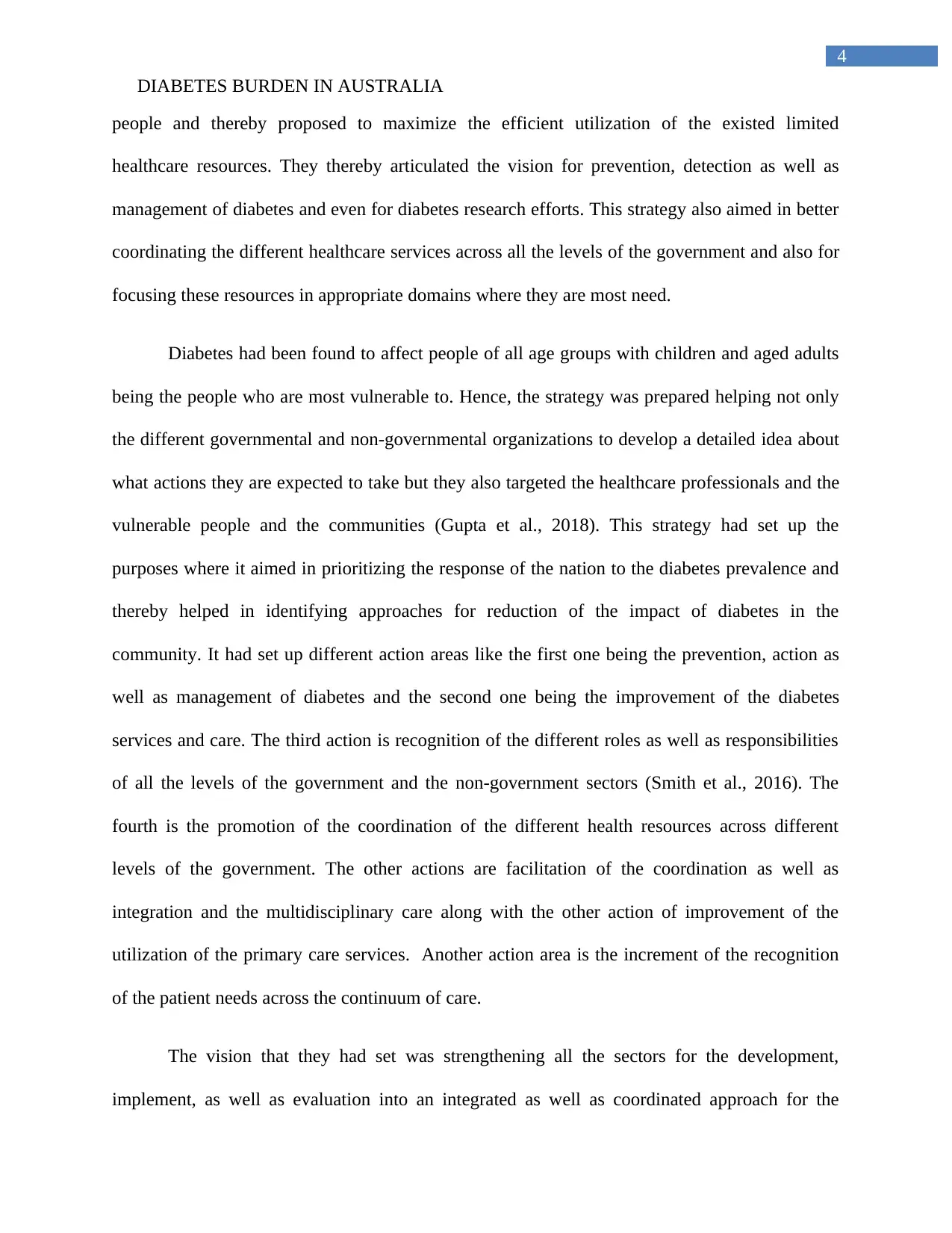
4
DIABETES BURDEN IN AUSTRALIA
people and thereby proposed to maximize the efficient utilization of the existed limited
healthcare resources. They thereby articulated the vision for prevention, detection as well as
management of diabetes and even for diabetes research efforts. This strategy also aimed in better
coordinating the different healthcare services across all the levels of the government and also for
focusing these resources in appropriate domains where they are most need.
Diabetes had been found to affect people of all age groups with children and aged adults
being the people who are most vulnerable to. Hence, the strategy was prepared helping not only
the different governmental and non-governmental organizations to develop a detailed idea about
what actions they are expected to take but they also targeted the healthcare professionals and the
vulnerable people and the communities (Gupta et al., 2018). This strategy had set up the
purposes where it aimed in prioritizing the response of the nation to the diabetes prevalence and
thereby helped in identifying approaches for reduction of the impact of diabetes in the
community. It had set up different action areas like the first one being the prevention, action as
well as management of diabetes and the second one being the improvement of the diabetes
services and care. The third action is recognition of the different roles as well as responsibilities
of all the levels of the government and the non-government sectors (Smith et al., 2016). The
fourth is the promotion of the coordination of the different health resources across different
levels of the government. The other actions are facilitation of the coordination as well as
integration and the multidisciplinary care along with the other action of improvement of the
utilization of the primary care services. Another action area is the increment of the recognition
of the patient needs across the continuum of care.
The vision that they had set was strengthening all the sectors for the development,
implement, as well as evaluation into an integrated as well as coordinated approach for the
DIABETES BURDEN IN AUSTRALIA
people and thereby proposed to maximize the efficient utilization of the existed limited
healthcare resources. They thereby articulated the vision for prevention, detection as well as
management of diabetes and even for diabetes research efforts. This strategy also aimed in better
coordinating the different healthcare services across all the levels of the government and also for
focusing these resources in appropriate domains where they are most need.
Diabetes had been found to affect people of all age groups with children and aged adults
being the people who are most vulnerable to. Hence, the strategy was prepared helping not only
the different governmental and non-governmental organizations to develop a detailed idea about
what actions they are expected to take but they also targeted the healthcare professionals and the
vulnerable people and the communities (Gupta et al., 2018). This strategy had set up the
purposes where it aimed in prioritizing the response of the nation to the diabetes prevalence and
thereby helped in identifying approaches for reduction of the impact of diabetes in the
community. It had set up different action areas like the first one being the prevention, action as
well as management of diabetes and the second one being the improvement of the diabetes
services and care. The third action is recognition of the different roles as well as responsibilities
of all the levels of the government and the non-government sectors (Smith et al., 2016). The
fourth is the promotion of the coordination of the different health resources across different
levels of the government. The other actions are facilitation of the coordination as well as
integration and the multidisciplinary care along with the other action of improvement of the
utilization of the primary care services. Another action area is the increment of the recognition
of the patient needs across the continuum of care.
The vision that they had set was strengthening all the sectors for the development,
implement, as well as evaluation into an integrated as well as coordinated approach for the
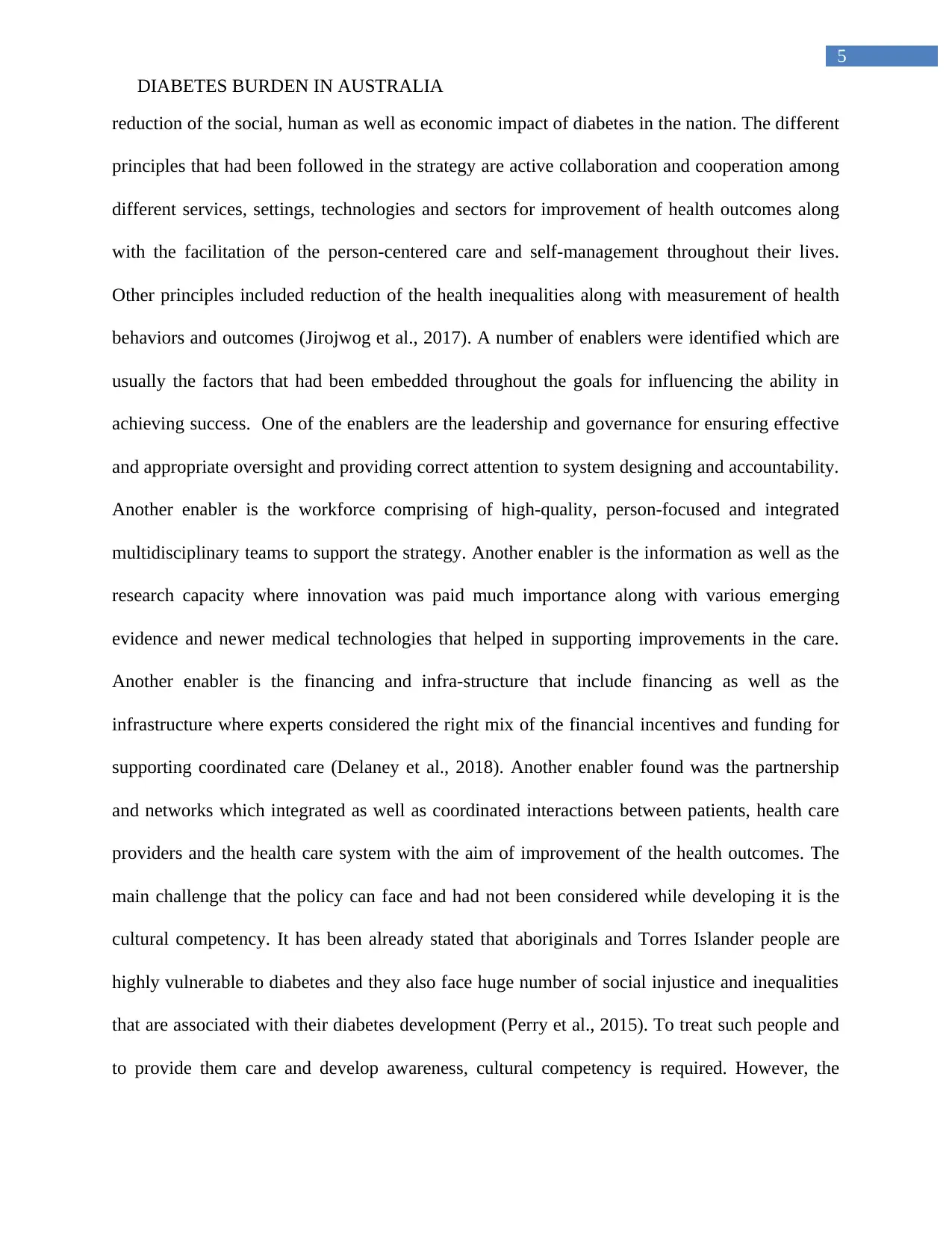
5
DIABETES BURDEN IN AUSTRALIA
reduction of the social, human as well as economic impact of diabetes in the nation. The different
principles that had been followed in the strategy are active collaboration and cooperation among
different services, settings, technologies and sectors for improvement of health outcomes along
with the facilitation of the person-centered care and self-management throughout their lives.
Other principles included reduction of the health inequalities along with measurement of health
behaviors and outcomes (Jirojwog et al., 2017). A number of enablers were identified which are
usually the factors that had been embedded throughout the goals for influencing the ability in
achieving success. One of the enablers are the leadership and governance for ensuring effective
and appropriate oversight and providing correct attention to system designing and accountability.
Another enabler is the workforce comprising of high-quality, person-focused and integrated
multidisciplinary teams to support the strategy. Another enabler is the information as well as the
research capacity where innovation was paid much importance along with various emerging
evidence and newer medical technologies that helped in supporting improvements in the care.
Another enabler is the financing and infra-structure that include financing as well as the
infrastructure where experts considered the right mix of the financial incentives and funding for
supporting coordinated care (Delaney et al., 2018). Another enabler found was the partnership
and networks which integrated as well as coordinated interactions between patients, health care
providers and the health care system with the aim of improvement of the health outcomes. The
main challenge that the policy can face and had not been considered while developing it is the
cultural competency. It has been already stated that aboriginals and Torres Islander people are
highly vulnerable to diabetes and they also face huge number of social injustice and inequalities
that are associated with their diabetes development (Perry et al., 2015). To treat such people and
to provide them care and develop awareness, cultural competency is required. However, the
DIABETES BURDEN IN AUSTRALIA
reduction of the social, human as well as economic impact of diabetes in the nation. The different
principles that had been followed in the strategy are active collaboration and cooperation among
different services, settings, technologies and sectors for improvement of health outcomes along
with the facilitation of the person-centered care and self-management throughout their lives.
Other principles included reduction of the health inequalities along with measurement of health
behaviors and outcomes (Jirojwog et al., 2017). A number of enablers were identified which are
usually the factors that had been embedded throughout the goals for influencing the ability in
achieving success. One of the enablers are the leadership and governance for ensuring effective
and appropriate oversight and providing correct attention to system designing and accountability.
Another enabler is the workforce comprising of high-quality, person-focused and integrated
multidisciplinary teams to support the strategy. Another enabler is the information as well as the
research capacity where innovation was paid much importance along with various emerging
evidence and newer medical technologies that helped in supporting improvements in the care.
Another enabler is the financing and infra-structure that include financing as well as the
infrastructure where experts considered the right mix of the financial incentives and funding for
supporting coordinated care (Delaney et al., 2018). Another enabler found was the partnership
and networks which integrated as well as coordinated interactions between patients, health care
providers and the health care system with the aim of improvement of the health outcomes. The
main challenge that the policy can face and had not been considered while developing it is the
cultural competency. It has been already stated that aboriginals and Torres Islander people are
highly vulnerable to diabetes and they also face huge number of social injustice and inequalities
that are associated with their diabetes development (Perry et al., 2015). To treat such people and
to provide them care and develop awareness, cultural competency is required. However, the
⊘ This is a preview!⊘
Do you want full access?
Subscribe today to unlock all pages.

Trusted by 1+ million students worldwide
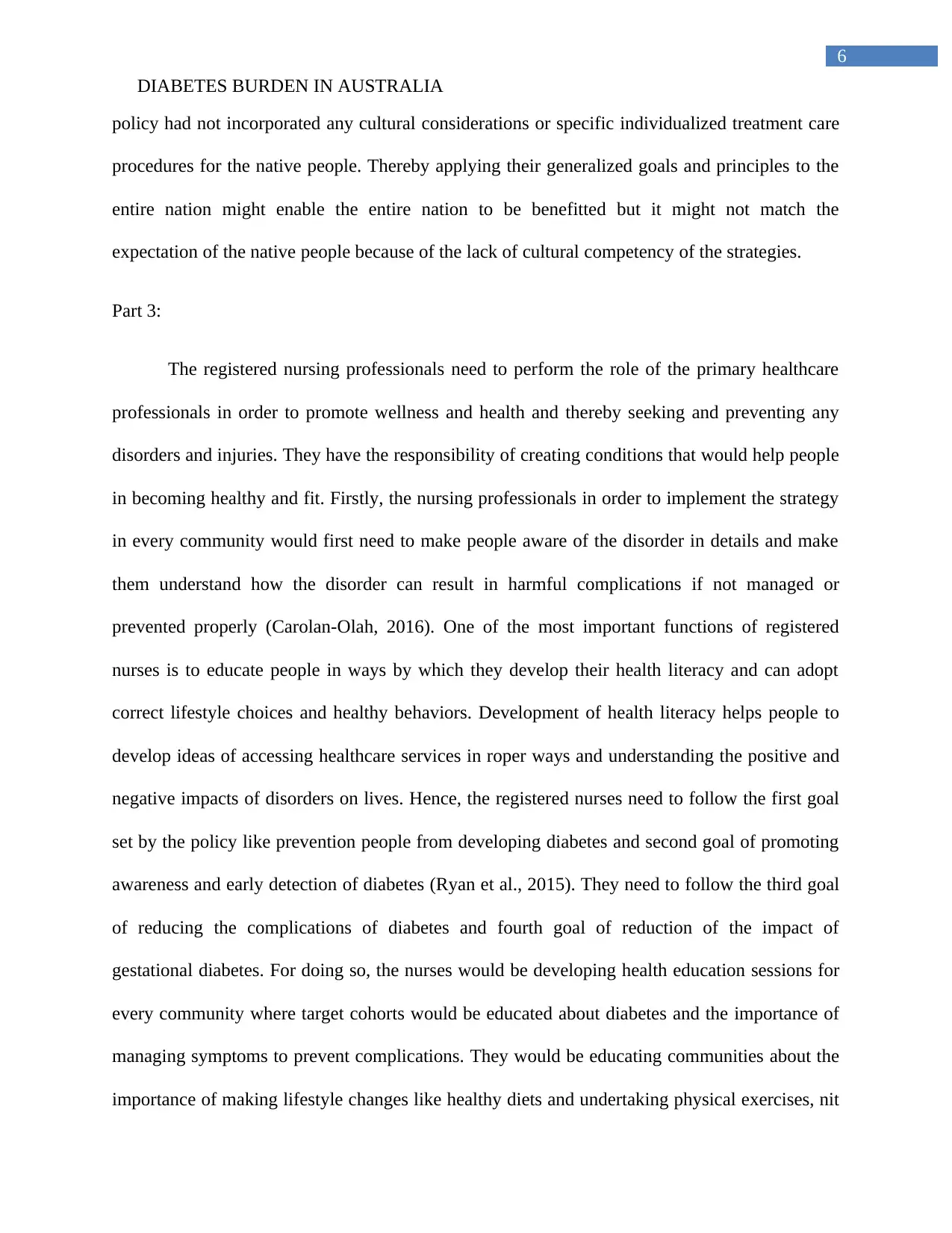
6
DIABETES BURDEN IN AUSTRALIA
policy had not incorporated any cultural considerations or specific individualized treatment care
procedures for the native people. Thereby applying their generalized goals and principles to the
entire nation might enable the entire nation to be benefitted but it might not match the
expectation of the native people because of the lack of cultural competency of the strategies.
Part 3:
The registered nursing professionals need to perform the role of the primary healthcare
professionals in order to promote wellness and health and thereby seeking and preventing any
disorders and injuries. They have the responsibility of creating conditions that would help people
in becoming healthy and fit. Firstly, the nursing professionals in order to implement the strategy
in every community would first need to make people aware of the disorder in details and make
them understand how the disorder can result in harmful complications if not managed or
prevented properly (Carolan-Olah, 2016). One of the most important functions of registered
nurses is to educate people in ways by which they develop their health literacy and can adopt
correct lifestyle choices and healthy behaviors. Development of health literacy helps people to
develop ideas of accessing healthcare services in roper ways and understanding the positive and
negative impacts of disorders on lives. Hence, the registered nurses need to follow the first goal
set by the policy like prevention people from developing diabetes and second goal of promoting
awareness and early detection of diabetes (Ryan et al., 2015). They need to follow the third goal
of reducing the complications of diabetes and fourth goal of reduction of the impact of
gestational diabetes. For doing so, the nurses would be developing health education sessions for
every community where target cohorts would be educated about diabetes and the importance of
managing symptoms to prevent complications. They would be educating communities about the
importance of making lifestyle changes like healthy diets and undertaking physical exercises, nit
DIABETES BURDEN IN AUSTRALIA
policy had not incorporated any cultural considerations or specific individualized treatment care
procedures for the native people. Thereby applying their generalized goals and principles to the
entire nation might enable the entire nation to be benefitted but it might not match the
expectation of the native people because of the lack of cultural competency of the strategies.
Part 3:
The registered nursing professionals need to perform the role of the primary healthcare
professionals in order to promote wellness and health and thereby seeking and preventing any
disorders and injuries. They have the responsibility of creating conditions that would help people
in becoming healthy and fit. Firstly, the nursing professionals in order to implement the strategy
in every community would first need to make people aware of the disorder in details and make
them understand how the disorder can result in harmful complications if not managed or
prevented properly (Carolan-Olah, 2016). One of the most important functions of registered
nurses is to educate people in ways by which they develop their health literacy and can adopt
correct lifestyle choices and healthy behaviors. Development of health literacy helps people to
develop ideas of accessing healthcare services in roper ways and understanding the positive and
negative impacts of disorders on lives. Hence, the registered nurses need to follow the first goal
set by the policy like prevention people from developing diabetes and second goal of promoting
awareness and early detection of diabetes (Ryan et al., 2015). They need to follow the third goal
of reducing the complications of diabetes and fourth goal of reduction of the impact of
gestational diabetes. For doing so, the nurses would be developing health education sessions for
every community where target cohorts would be educated about diabetes and the importance of
managing symptoms to prevent complications. They would be educating communities about the
importance of making lifestyle changes like healthy diets and undertaking physical exercises, nit
Paraphrase This Document
Need a fresh take? Get an instant paraphrase of this document with our AI Paraphraser
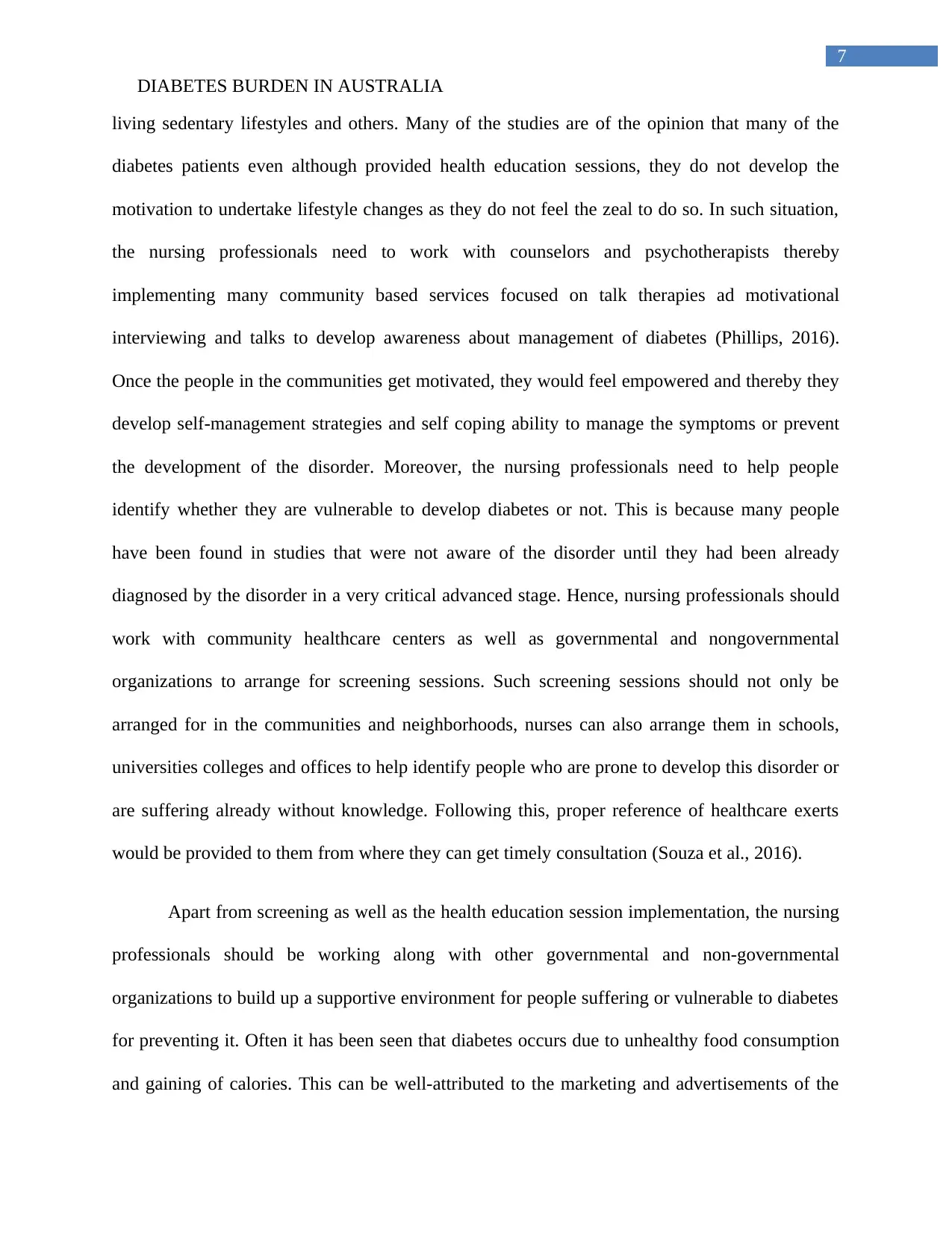
7
DIABETES BURDEN IN AUSTRALIA
living sedentary lifestyles and others. Many of the studies are of the opinion that many of the
diabetes patients even although provided health education sessions, they do not develop the
motivation to undertake lifestyle changes as they do not feel the zeal to do so. In such situation,
the nursing professionals need to work with counselors and psychotherapists thereby
implementing many community based services focused on talk therapies ad motivational
interviewing and talks to develop awareness about management of diabetes (Phillips, 2016).
Once the people in the communities get motivated, they would feel empowered and thereby they
develop self-management strategies and self coping ability to manage the symptoms or prevent
the development of the disorder. Moreover, the nursing professionals need to help people
identify whether they are vulnerable to develop diabetes or not. This is because many people
have been found in studies that were not aware of the disorder until they had been already
diagnosed by the disorder in a very critical advanced stage. Hence, nursing professionals should
work with community healthcare centers as well as governmental and nongovernmental
organizations to arrange for screening sessions. Such screening sessions should not only be
arranged for in the communities and neighborhoods, nurses can also arrange them in schools,
universities colleges and offices to help identify people who are prone to develop this disorder or
are suffering already without knowledge. Following this, proper reference of healthcare exerts
would be provided to them from where they can get timely consultation (Souza et al., 2016).
Apart from screening as well as the health education session implementation, the nursing
professionals should be working along with other governmental and non-governmental
organizations to build up a supportive environment for people suffering or vulnerable to diabetes
for preventing it. Often it has been seen that diabetes occurs due to unhealthy food consumption
and gaining of calories. This can be well-attributed to the marketing and advertisements of the
DIABETES BURDEN IN AUSTRALIA
living sedentary lifestyles and others. Many of the studies are of the opinion that many of the
diabetes patients even although provided health education sessions, they do not develop the
motivation to undertake lifestyle changes as they do not feel the zeal to do so. In such situation,
the nursing professionals need to work with counselors and psychotherapists thereby
implementing many community based services focused on talk therapies ad motivational
interviewing and talks to develop awareness about management of diabetes (Phillips, 2016).
Once the people in the communities get motivated, they would feel empowered and thereby they
develop self-management strategies and self coping ability to manage the symptoms or prevent
the development of the disorder. Moreover, the nursing professionals need to help people
identify whether they are vulnerable to develop diabetes or not. This is because many people
have been found in studies that were not aware of the disorder until they had been already
diagnosed by the disorder in a very critical advanced stage. Hence, nursing professionals should
work with community healthcare centers as well as governmental and nongovernmental
organizations to arrange for screening sessions. Such screening sessions should not only be
arranged for in the communities and neighborhoods, nurses can also arrange them in schools,
universities colleges and offices to help identify people who are prone to develop this disorder or
are suffering already without knowledge. Following this, proper reference of healthcare exerts
would be provided to them from where they can get timely consultation (Souza et al., 2016).
Apart from screening as well as the health education session implementation, the nursing
professionals should be working along with other governmental and non-governmental
organizations to build up a supportive environment for people suffering or vulnerable to diabetes
for preventing it. Often it has been seen that diabetes occurs due to unhealthy food consumption
and gaining of calories. This can be well-attributed to the marketing and advertisements of the
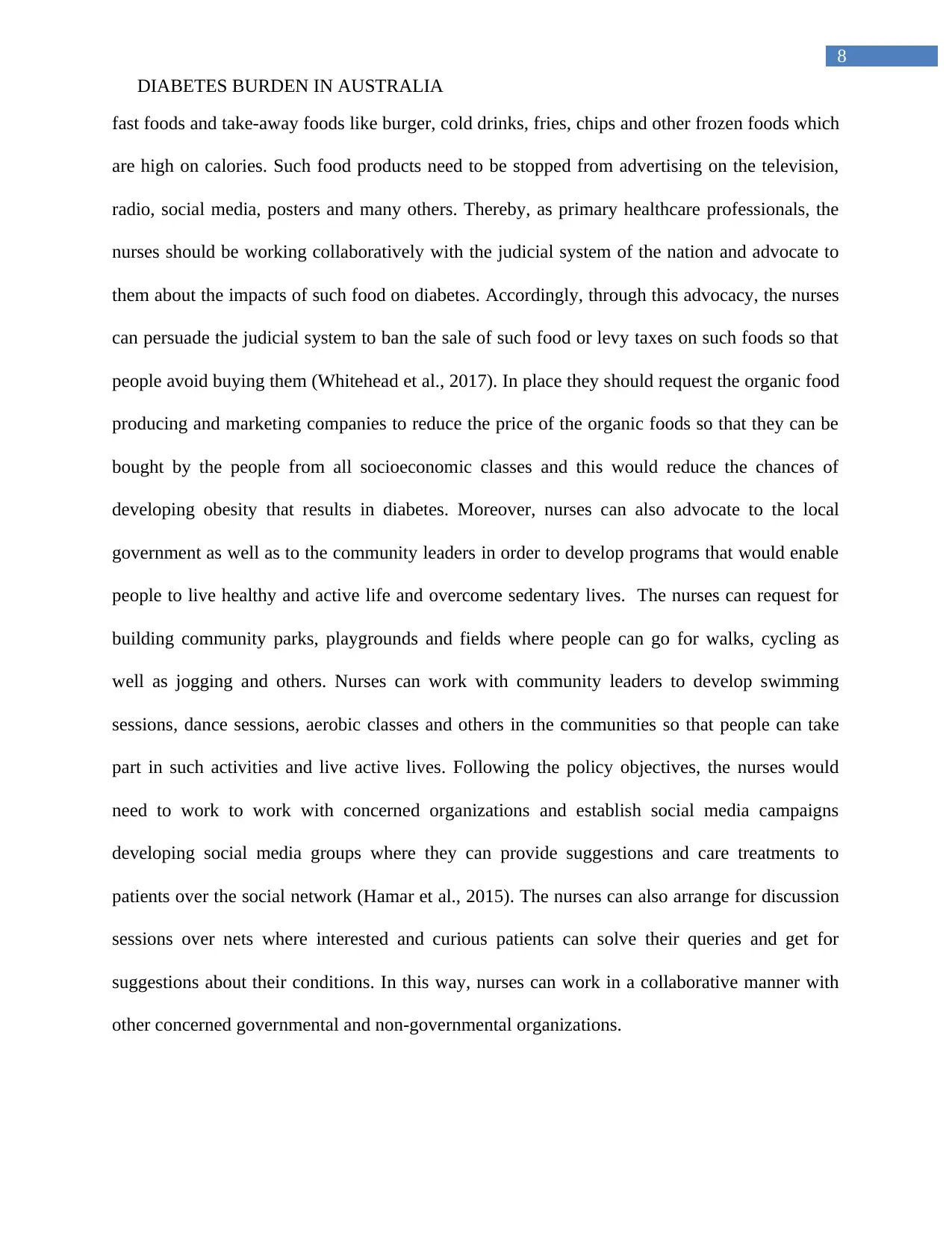
8
DIABETES BURDEN IN AUSTRALIA
fast foods and take-away foods like burger, cold drinks, fries, chips and other frozen foods which
are high on calories. Such food products need to be stopped from advertising on the television,
radio, social media, posters and many others. Thereby, as primary healthcare professionals, the
nurses should be working collaboratively with the judicial system of the nation and advocate to
them about the impacts of such food on diabetes. Accordingly, through this advocacy, the nurses
can persuade the judicial system to ban the sale of such food or levy taxes on such foods so that
people avoid buying them (Whitehead et al., 2017). In place they should request the organic food
producing and marketing companies to reduce the price of the organic foods so that they can be
bought by the people from all socioeconomic classes and this would reduce the chances of
developing obesity that results in diabetes. Moreover, nurses can also advocate to the local
government as well as to the community leaders in order to develop programs that would enable
people to live healthy and active life and overcome sedentary lives. The nurses can request for
building community parks, playgrounds and fields where people can go for walks, cycling as
well as jogging and others. Nurses can work with community leaders to develop swimming
sessions, dance sessions, aerobic classes and others in the communities so that people can take
part in such activities and live active lives. Following the policy objectives, the nurses would
need to work to work with concerned organizations and establish social media campaigns
developing social media groups where they can provide suggestions and care treatments to
patients over the social network (Hamar et al., 2015). The nurses can also arrange for discussion
sessions over nets where interested and curious patients can solve their queries and get for
suggestions about their conditions. In this way, nurses can work in a collaborative manner with
other concerned governmental and non-governmental organizations.
DIABETES BURDEN IN AUSTRALIA
fast foods and take-away foods like burger, cold drinks, fries, chips and other frozen foods which
are high on calories. Such food products need to be stopped from advertising on the television,
radio, social media, posters and many others. Thereby, as primary healthcare professionals, the
nurses should be working collaboratively with the judicial system of the nation and advocate to
them about the impacts of such food on diabetes. Accordingly, through this advocacy, the nurses
can persuade the judicial system to ban the sale of such food or levy taxes on such foods so that
people avoid buying them (Whitehead et al., 2017). In place they should request the organic food
producing and marketing companies to reduce the price of the organic foods so that they can be
bought by the people from all socioeconomic classes and this would reduce the chances of
developing obesity that results in diabetes. Moreover, nurses can also advocate to the local
government as well as to the community leaders in order to develop programs that would enable
people to live healthy and active life and overcome sedentary lives. The nurses can request for
building community parks, playgrounds and fields where people can go for walks, cycling as
well as jogging and others. Nurses can work with community leaders to develop swimming
sessions, dance sessions, aerobic classes and others in the communities so that people can take
part in such activities and live active lives. Following the policy objectives, the nurses would
need to work to work with concerned organizations and establish social media campaigns
developing social media groups where they can provide suggestions and care treatments to
patients over the social network (Hamar et al., 2015). The nurses can also arrange for discussion
sessions over nets where interested and curious patients can solve their queries and get for
suggestions about their conditions. In this way, nurses can work in a collaborative manner with
other concerned governmental and non-governmental organizations.
⊘ This is a preview!⊘
Do you want full access?
Subscribe today to unlock all pages.

Trusted by 1+ million students worldwide
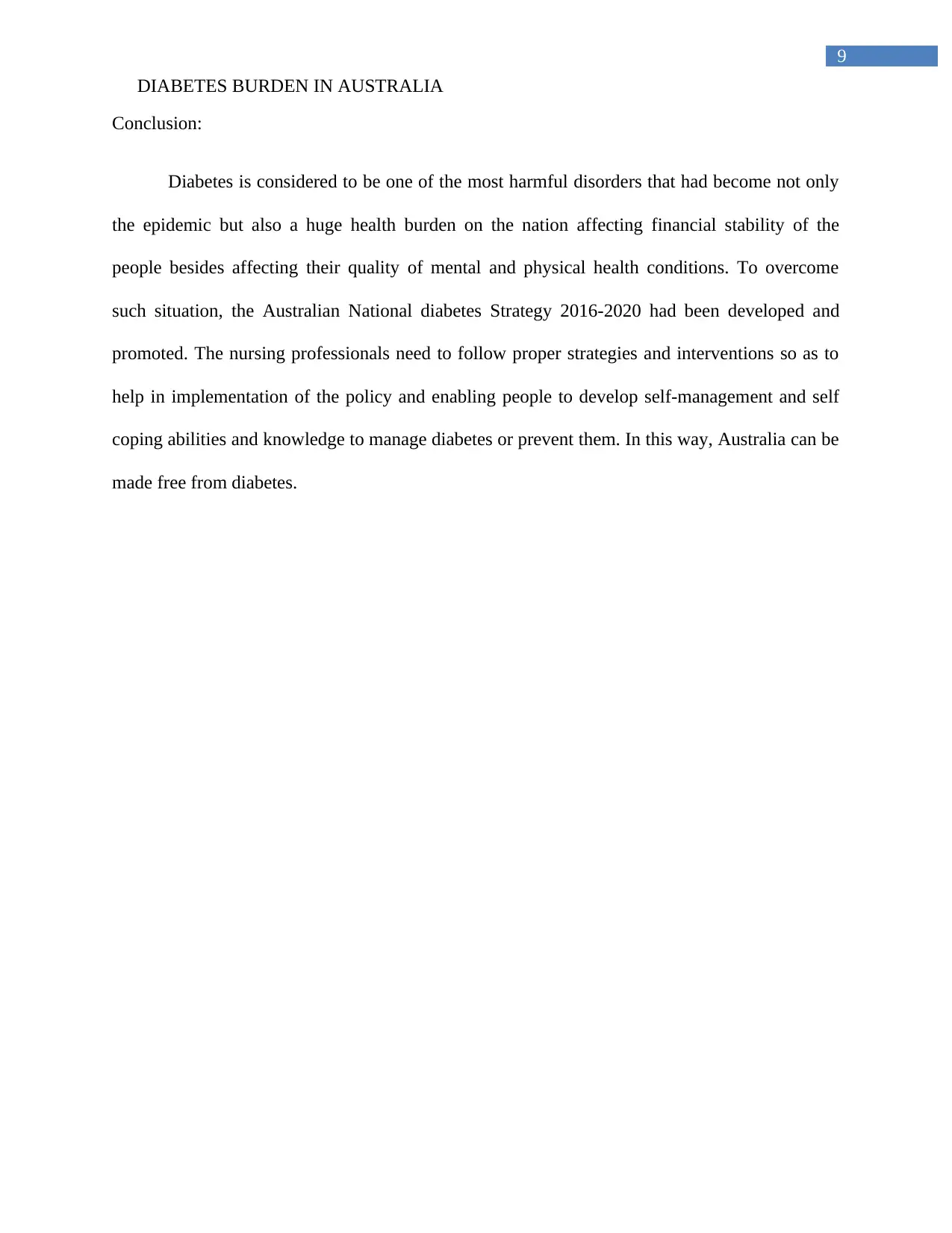
9
DIABETES BURDEN IN AUSTRALIA
Conclusion:
Diabetes is considered to be one of the most harmful disorders that had become not only
the epidemic but also a huge health burden on the nation affecting financial stability of the
people besides affecting their quality of mental and physical health conditions. To overcome
such situation, the Australian National diabetes Strategy 2016-2020 had been developed and
promoted. The nursing professionals need to follow proper strategies and interventions so as to
help in implementation of the policy and enabling people to develop self-management and self
coping abilities and knowledge to manage diabetes or prevent them. In this way, Australia can be
made free from diabetes.
DIABETES BURDEN IN AUSTRALIA
Conclusion:
Diabetes is considered to be one of the most harmful disorders that had become not only
the epidemic but also a huge health burden on the nation affecting financial stability of the
people besides affecting their quality of mental and physical health conditions. To overcome
such situation, the Australian National diabetes Strategy 2016-2020 had been developed and
promoted. The nursing professionals need to follow proper strategies and interventions so as to
help in implementation of the policy and enabling people to develop self-management and self
coping abilities and knowledge to manage diabetes or prevent them. In this way, Australia can be
made free from diabetes.
Paraphrase This Document
Need a fresh take? Get an instant paraphrase of this document with our AI Paraphraser
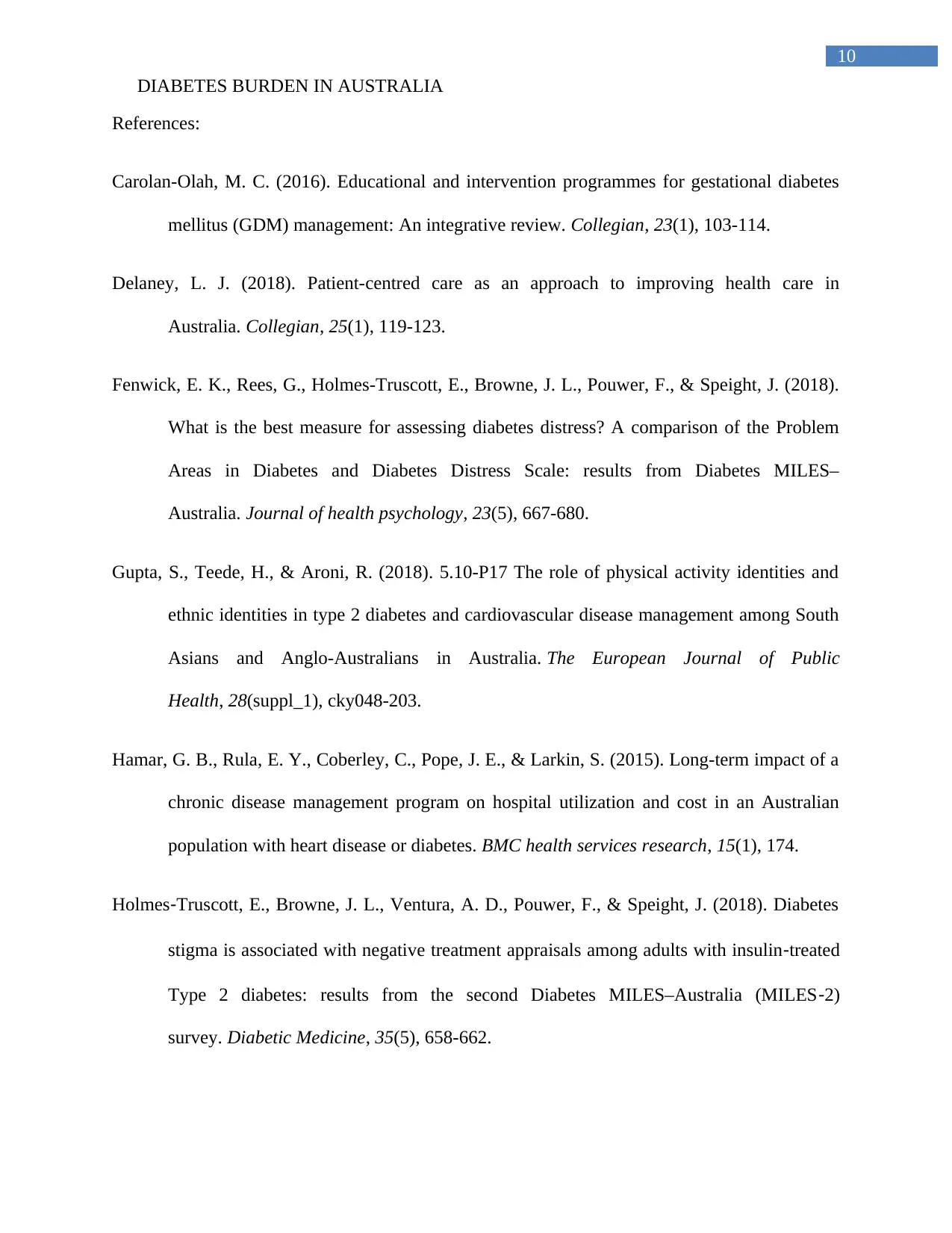
10
DIABETES BURDEN IN AUSTRALIA
References:
Carolan-Olah, M. C. (2016). Educational and intervention programmes for gestational diabetes
mellitus (GDM) management: An integrative review. Collegian, 23(1), 103-114.
Delaney, L. J. (2018). Patient-centred care as an approach to improving health care in
Australia. Collegian, 25(1), 119-123.
Fenwick, E. K., Rees, G., Holmes-Truscott, E., Browne, J. L., Pouwer, F., & Speight, J. (2018).
What is the best measure for assessing diabetes distress? A comparison of the Problem
Areas in Diabetes and Diabetes Distress Scale: results from Diabetes MILES–
Australia. Journal of health psychology, 23(5), 667-680.
Gupta, S., Teede, H., & Aroni, R. (2018). 5.10-P17 The role of physical activity identities and
ethnic identities in type 2 diabetes and cardiovascular disease management among South
Asians and Anglo-Australians in Australia. The European Journal of Public
Health, 28(suppl_1), cky048-203.
Hamar, G. B., Rula, E. Y., Coberley, C., Pope, J. E., & Larkin, S. (2015). Long-term impact of a
chronic disease management program on hospital utilization and cost in an Australian
population with heart disease or diabetes. BMC health services research, 15(1), 174.
Holmes‐Truscott, E., Browne, J. L., Ventura, A. D., Pouwer, F., & Speight, J. (2018). Diabetes
stigma is associated with negative treatment appraisals among adults with insulin‐treated
Type 2 diabetes: results from the second Diabetes MILES–Australia (MILES‐2)
survey. Diabetic Medicine, 35(5), 658-662.
DIABETES BURDEN IN AUSTRALIA
References:
Carolan-Olah, M. C. (2016). Educational and intervention programmes for gestational diabetes
mellitus (GDM) management: An integrative review. Collegian, 23(1), 103-114.
Delaney, L. J. (2018). Patient-centred care as an approach to improving health care in
Australia. Collegian, 25(1), 119-123.
Fenwick, E. K., Rees, G., Holmes-Truscott, E., Browne, J. L., Pouwer, F., & Speight, J. (2018).
What is the best measure for assessing diabetes distress? A comparison of the Problem
Areas in Diabetes and Diabetes Distress Scale: results from Diabetes MILES–
Australia. Journal of health psychology, 23(5), 667-680.
Gupta, S., Teede, H., & Aroni, R. (2018). 5.10-P17 The role of physical activity identities and
ethnic identities in type 2 diabetes and cardiovascular disease management among South
Asians and Anglo-Australians in Australia. The European Journal of Public
Health, 28(suppl_1), cky048-203.
Hamar, G. B., Rula, E. Y., Coberley, C., Pope, J. E., & Larkin, S. (2015). Long-term impact of a
chronic disease management program on hospital utilization and cost in an Australian
population with heart disease or diabetes. BMC health services research, 15(1), 174.
Holmes‐Truscott, E., Browne, J. L., Ventura, A. D., Pouwer, F., & Speight, J. (2018). Diabetes
stigma is associated with negative treatment appraisals among adults with insulin‐treated
Type 2 diabetes: results from the second Diabetes MILES–Australia (MILES‐2)
survey. Diabetic Medicine, 35(5), 658-662.
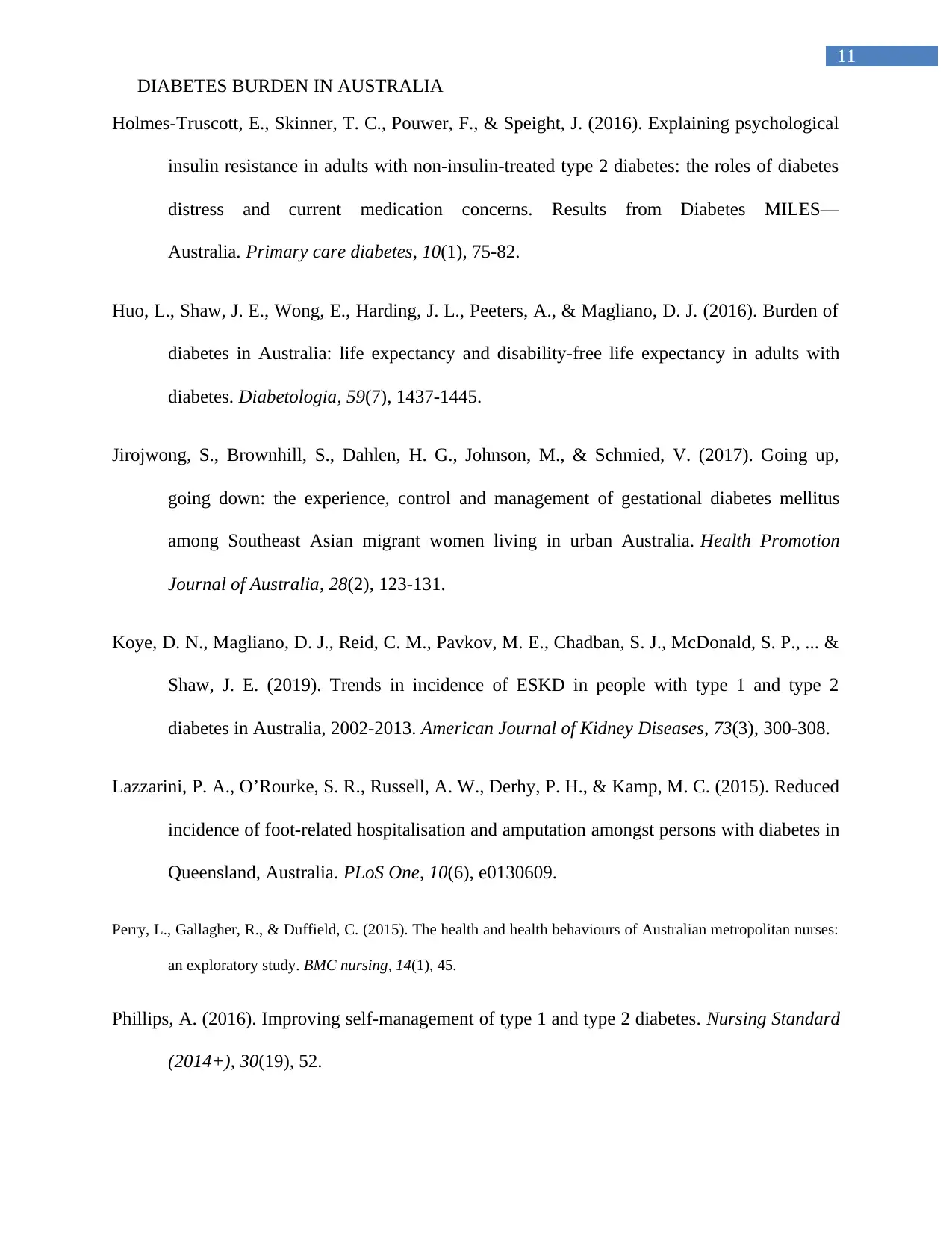
11
DIABETES BURDEN IN AUSTRALIA
Holmes-Truscott, E., Skinner, T. C., Pouwer, F., & Speight, J. (2016). Explaining psychological
insulin resistance in adults with non-insulin-treated type 2 diabetes: the roles of diabetes
distress and current medication concerns. Results from Diabetes MILES—
Australia. Primary care diabetes, 10(1), 75-82.
Huo, L., Shaw, J. E., Wong, E., Harding, J. L., Peeters, A., & Magliano, D. J. (2016). Burden of
diabetes in Australia: life expectancy and disability-free life expectancy in adults with
diabetes. Diabetologia, 59(7), 1437-1445.
Jirojwong, S., Brownhill, S., Dahlen, H. G., Johnson, M., & Schmied, V. (2017). Going up,
going down: the experience, control and management of gestational diabetes mellitus
among Southeast Asian migrant women living in urban Australia. Health Promotion
Journal of Australia, 28(2), 123-131.
Koye, D. N., Magliano, D. J., Reid, C. M., Pavkov, M. E., Chadban, S. J., McDonald, S. P., ... &
Shaw, J. E. (2019). Trends in incidence of ESKD in people with type 1 and type 2
diabetes in Australia, 2002-2013. American Journal of Kidney Diseases, 73(3), 300-308.
Lazzarini, P. A., O’Rourke, S. R., Russell, A. W., Derhy, P. H., & Kamp, M. C. (2015). Reduced
incidence of foot-related hospitalisation and amputation amongst persons with diabetes in
Queensland, Australia. PLoS One, 10(6), e0130609.
Perry, L., Gallagher, R., & Duffield, C. (2015). The health and health behaviours of Australian metropolitan nurses:
an exploratory study. BMC nursing, 14(1), 45.
Phillips, A. (2016). Improving self-management of type 1 and type 2 diabetes. Nursing Standard
(2014+), 30(19), 52.
DIABETES BURDEN IN AUSTRALIA
Holmes-Truscott, E., Skinner, T. C., Pouwer, F., & Speight, J. (2016). Explaining psychological
insulin resistance in adults with non-insulin-treated type 2 diabetes: the roles of diabetes
distress and current medication concerns. Results from Diabetes MILES—
Australia. Primary care diabetes, 10(1), 75-82.
Huo, L., Shaw, J. E., Wong, E., Harding, J. L., Peeters, A., & Magliano, D. J. (2016). Burden of
diabetes in Australia: life expectancy and disability-free life expectancy in adults with
diabetes. Diabetologia, 59(7), 1437-1445.
Jirojwong, S., Brownhill, S., Dahlen, H. G., Johnson, M., & Schmied, V. (2017). Going up,
going down: the experience, control and management of gestational diabetes mellitus
among Southeast Asian migrant women living in urban Australia. Health Promotion
Journal of Australia, 28(2), 123-131.
Koye, D. N., Magliano, D. J., Reid, C. M., Pavkov, M. E., Chadban, S. J., McDonald, S. P., ... &
Shaw, J. E. (2019). Trends in incidence of ESKD in people with type 1 and type 2
diabetes in Australia, 2002-2013. American Journal of Kidney Diseases, 73(3), 300-308.
Lazzarini, P. A., O’Rourke, S. R., Russell, A. W., Derhy, P. H., & Kamp, M. C. (2015). Reduced
incidence of foot-related hospitalisation and amputation amongst persons with diabetes in
Queensland, Australia. PLoS One, 10(6), e0130609.
Perry, L., Gallagher, R., & Duffield, C. (2015). The health and health behaviours of Australian metropolitan nurses:
an exploratory study. BMC nursing, 14(1), 45.
Phillips, A. (2016). Improving self-management of type 1 and type 2 diabetes. Nursing Standard
(2014+), 30(19), 52.
⊘ This is a preview!⊘
Do you want full access?
Subscribe today to unlock all pages.

Trusted by 1+ million students worldwide
1 out of 14
Related Documents
Your All-in-One AI-Powered Toolkit for Academic Success.
+13062052269
info@desklib.com
Available 24*7 on WhatsApp / Email
![[object Object]](/_next/static/media/star-bottom.7253800d.svg)
Unlock your academic potential
Copyright © 2020–2025 A2Z Services. All Rights Reserved. Developed and managed by ZUCOL.





